#or at least 88.5 of them
Explore tagged Tumblr posts
Text

My car's radio station display is horribly dysfunctional and I love it, because every evening I can turn on NPR and listen to Things.
#NPR#88.5 Things#to be precise#no it doesn't scroll#why would it do that?#all things considered#or at least 88.5 of them
21 notes
·
View notes
Text

//Ayo it's a meta/hc heavy day. I would like to formally apologize to & thank @/sunniestshark for suffering my infodump about Karin & the Kurosaki family. I owe you my life.
This focuses specifically on the details & timeline of Karin's development of "I don't see spirits" to "I'm the Spirit Guy(tm) of the family" to "why the fuck is my brother, a trained combatant, not teaching me how to Not Die from hollows?" & how this affected the Kurosaki family.
We see in ch 1 that spirits are a) a common occurrence in the family, b) Yuzu can see spirits, albeit faintly, & c) Karin largely ignores spirits.


This attitude drastically changes in the Fullbringer arc. In ch 428, while she visits the Urahara Shouten for spiritual repellant, Karin seems to acknowledge spiritual capability more, & is happy to take the burden of the family's spiritual issues so Ichigo doesn't have to.


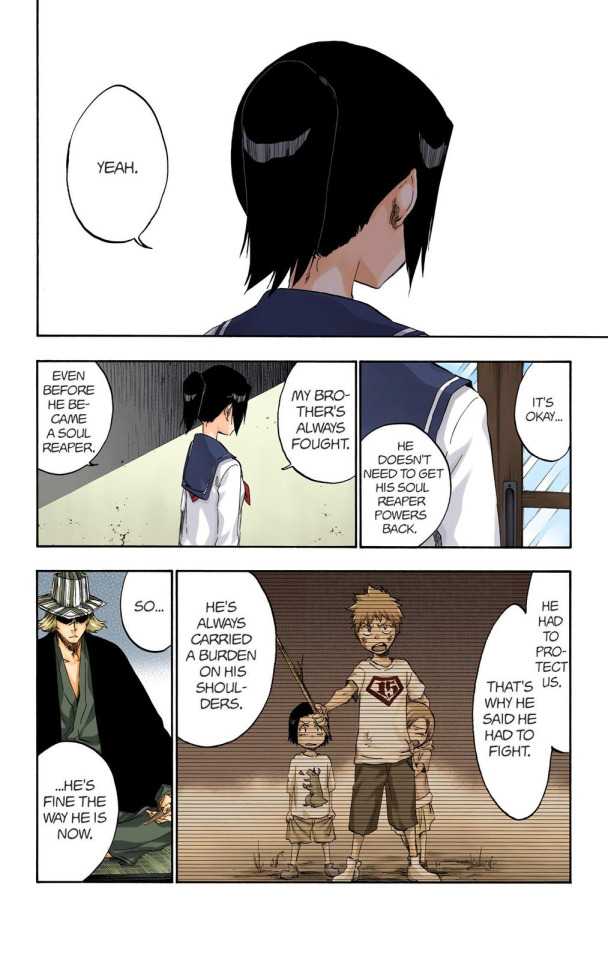

Karakura is a town inundated with malevolent spirits. Ichigo is frequently pulled out of class & woken in the middle of the night to address hollows (it's literally 90% the plot of the premier arc, so I will not be providing examples), & even after Sousuke is incarcerated & unable to sick weird hollow experiments on innocent townspeople (White & Metastacia are the first to come to mind) they're still frequent enough that Ichigo expresses in 424 that Uryuu takes care of a lot hollow problems, even being pulled out of class.
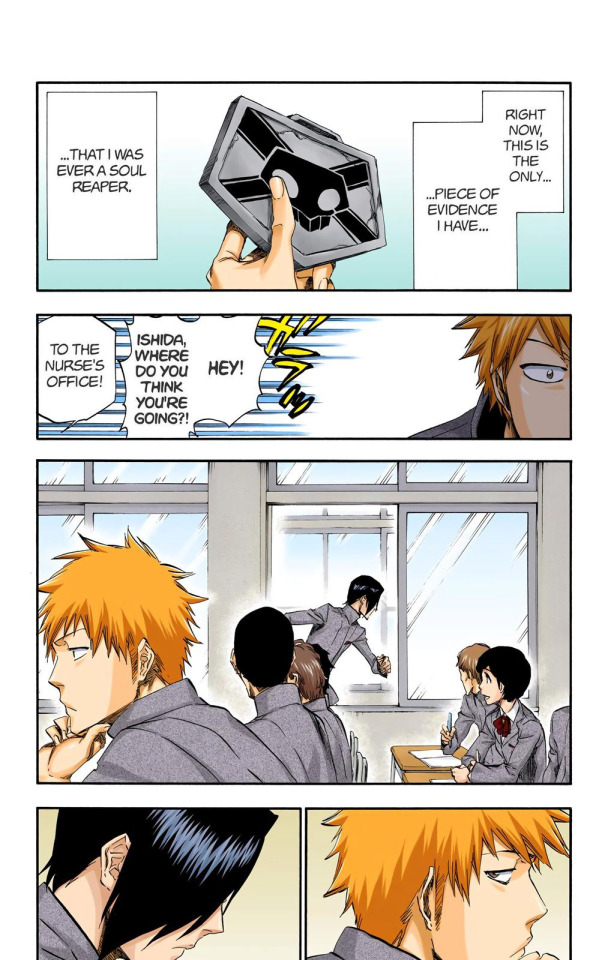

Additionally, it's not an uncommon occurrence in Karakura that the city experiences an ambush of many hollows. Just off the top of my head, Ryuunosuke & Shino are ambushed by no fewer than like six hollows in ch 482 & have to be rescued by Ichigo.
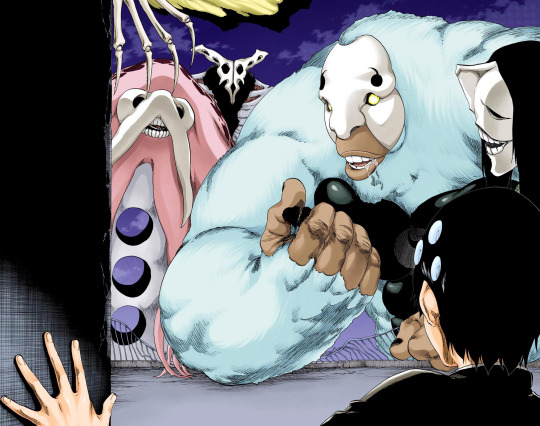

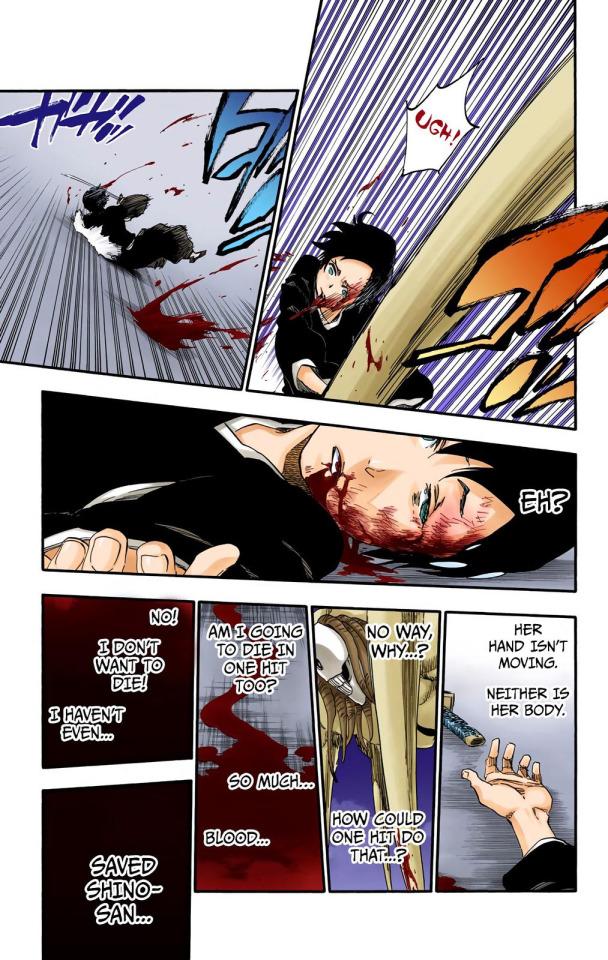
So Karin, who is spiritually capable enough to fight hollows with no training alongside Jinta, Ururu, & Don Kanonji in ch 88.5, is in a town literally drowning in cannibalistic monsters.
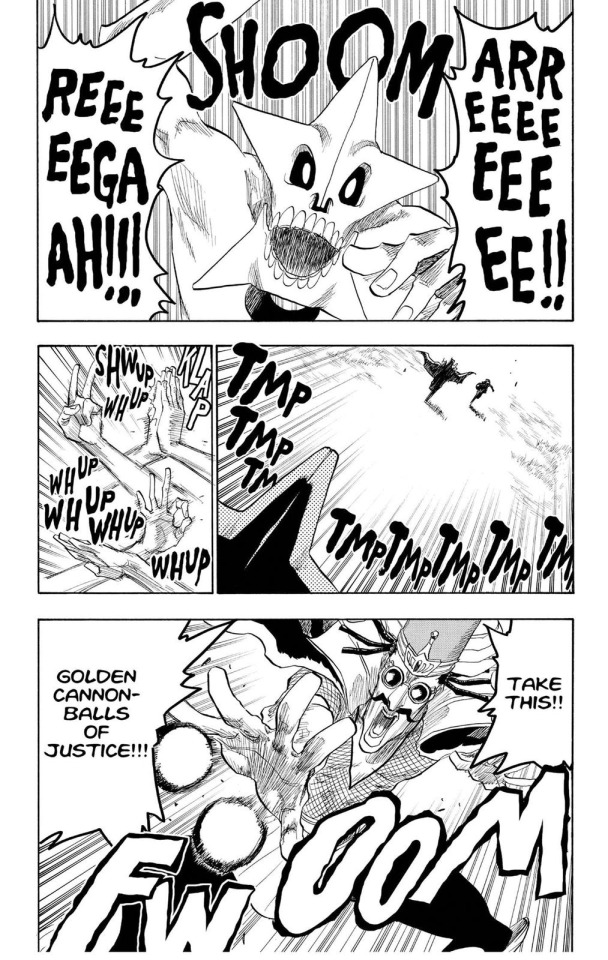
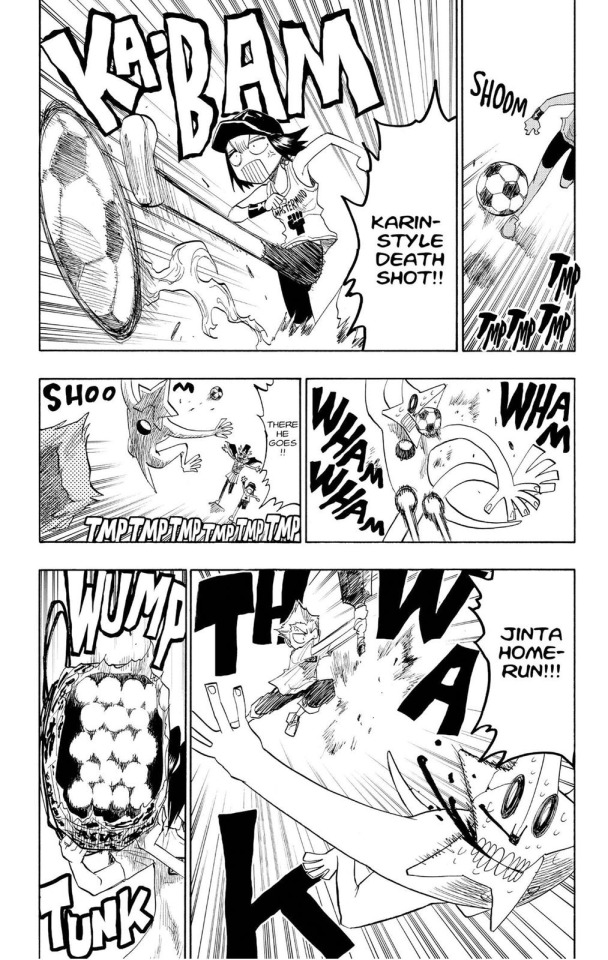

Despite her capability, Karin still needs help fighting. She isn't able to kill it on her own. It's perfectly feasible she'd be killed if left alone with the wrong hollow.
Obviously, any thirteen year old who's as insular as Karin is wouldn't seek help, but she would have to later on for survival. But there's no indication anyone really offers training. It's understandable why Kisuke wouldn't, but you'd expect, at the very least, Isshin to do the smart thing & stop coddling his daughters & teach them how to defend themselves. But he doesn't.
This is where meta turns into canon divergence.
Karin still fights hollows with Jinta & Ururu. She discovers her love for fighting hollows during this time. However, Ichigo feels Karin doesn't need to pursue combat now that he has his powers back. This makes Karin resent Ichigo. She says it's because she's gone to great lengths to keep Ichigo's status as a shinigami a secret, but she doesn't want to admit she's hurt & feels abandoned that her brother refuses to help her protect herself & do something she loves.
Their relationship continues to sour & eventually, it bleeds into the rest of the family when they start having outright screaming matches. During this time, Karin falls into depression, & most of her negative feelings culminate in self-injury since she hasn't developed effective coping mechanisms. During this time, her grades fall, she stops playing soccer, she starts smoking tobacco & marijuana, drinks, & once she enters high school, begins having one-night stands.
Karin kills herself after graduating high school. This implodes the family. They survived Masaki's death because Ichigo, Yuzu, & Karin were so young & needed Isshin for survival. However, they're adults now. I don't see how everything that's happened doesn't come to light. Yuzu finds out that Isshin & Ichigo are shinigami & is furious they've kept these secrets from her, & Yuzu is hurt that Karin, who we've seen share a bed before, has abandoned her.
I don't think Karin cutting ties with the family would dissolve it. But Yuzu is the matriarch. She cooks, cleans, & handles most of the household affairs. Yuzu & Karin cutting ties would dissolve the family.
4 notes
·
View notes
Text
Spider Touhou Results
Here I have the results from the little test we did. Figured I'd post them since folks were kind enough to help out with that (special thanks to 140, who answered the survey over 1000 times). Full results may take a few posts, but without further ado...
The Top 8 Most Spidery Touhous (as decided by a fairly limited sample size)


#1 and 2 belong to Yamame and Joon, who managed to win 88.5% and 81.3% percent of their matches, respectively. No great surprise that a literal spider would top the chart, but a bit unexpected that Joon would be joining her in the 80+% category. Guess those big goggles do her no favors in this category.



#3, 4, and 5 belong to Parsee, Nue, Chiyari, all in the mid-70% range. Nue continues the appearance trend, but the other two seemed to rely more on abilities and lifestyle (both quite toxic). After all, there can only be so many characters that actually look like spiders.


Continuing the trend of Former hell dominance, Koishi and Satori poetically take slots #6 and 7. Is it their eyes, the weird tendril-things, or do people just think spiders live underground and have psychic powers?

Lastly, coming in with a 70% win rate for #8 is Shinki. I got nothing for this one I'm afraid. I'll assume the voters know what their talking about here.
After this, the results start to plateau (at least until the lower values, which I'll get to next), but two honorable mentions include Yukari, who arrived at #10 and Reimu, who managed to win exactly 50% of her matches.
Stay tuned for the "losers" and the full results!
5 notes
·
View notes
Note
does pete white listen to devo
Pete White almost definitely played DEVO on his college radio station at State (88.5 KSTA, maybe?).
thanks for your question, JujuonthatBeat360. Reader: you too can ask questions, believe it or not!
Embraced them early as the wackier, performance-art end of Punk/New Wave, Pete definitely bought Q: Are We Not Men... in high school but it wasn't, like, his favorite. He would have dropped them like a hot spud after Whip It got heavy rotation on early MTV, causing the squares to call DEVO a "one hit wonder."
White's not a fan— DEVO doesn't fuck. More Billy & White 2022 →
His core New Wave electro-pop /New Romantic aesthetic is sexy... longing, angsty or at least something to can gyrate to on a dance floor. DEVO isn't cool— they're anti-cool— and Pete wants to come off as cool (but usually fails). He prefers British New Wave acts; the American ones are either heady or goofy and DEVO is both.
DEVO is intentionally geeky— asexual even, forgiving Jerkin' Back and Forth— dressing in weird hats and jumpsuits, making inscrutable films, and chant-singing about the de-evolution of humanity but it's secretly about the Reaganite 1980s. It's core NERD music.
Considering that, Billy would probably be the more likely DEVO devotee. It's spectacle. It's high-concept. It plays on science fiction/actual science tropes. TONS of MERCH to collect, much of it rare — Billy never met a cult following he wouldn't buy his way into.

genuine DEVO fan club energy dome and paper speed suit.
More Billy & White 2022 →
#ask#your question#answer#DEVO#headcanons#vbros#the venture brothers#the venture bros#dyna moe#1980s#new wave#post punk#q and a#my asks#your asks#fanfic#petebilly#pete white#billy quizboy
24 notes
·
View notes
Text
Yankees (9-12) at Orioles (9-12)
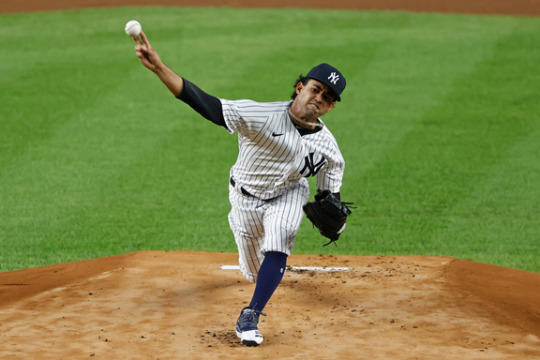
Game One – Monday at 705pm on YES: Deivi Garcia (first start) vs Matt Harvey (1-1, 5.12 ERA)
Game Two – Tuesday at 705pm on WPIX: Corey Kluber (0-2, 5.40 ERA) vs Bruce Zimmerman (4.57 ERA) Game Three – Wednesday at 705pm on YES: Domingo German (1-2, 6.23 ERA) vs TBD (Likely Dean Kremer, who is 0-1 with a 6.75 ERA)
Game Four – Thursday at 105pm on YES and MLBN: Jordan Montgomery (1-1, 4.57 ERA) vs Jorge Lopez (1-3, 8.15 ERA)
Orioles Injury Report
RHP Mac Sceroler – On the 10 Day IL with shoulder tendinitis, no timetable for return
RHP Hunter Harvey – On the 60 Day IL with a strained oblique, no timetable for return
OF Anthony Santander – On the 10 Day IL with a sprained ankle, expected back in the middle of May
DH Chris Davis – On the 60 Day IL with a strained back, no timetable for return
Orioles Pitching

Baltimore’s pitching is similar to the Yankees in a few ways—they are 15th in baseball in ERA, don’t walk a lot of guys, their bullpen has been pretty strong, but their rotation is one really good pitcher and four meh ones. Luckily for the Yanks, their really good pitcher (Means) started on Sunday and will miss the series.
Tuesday’s starter is Matt Harvey, who is someone I’m not sure why he continues to get opportunities to be a starter in Major League Baseball? Harvey has his best ERA+ since his heyday in 2015 this year, at a whopping 84 ERA+. The one thing he’s been really good at the last few years is his walk rate, which this year is all the way down to 3.4%. However, his walk rate being that low is honestly a really bad thing:
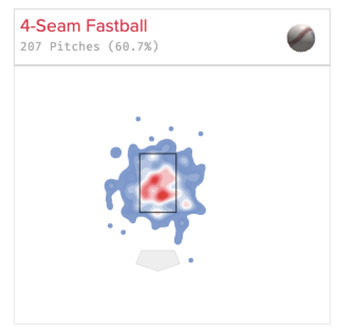
Throwing a 93mph fastball in the middle of the zone over and over again is a really easy way to get lit up, and people aren’t exactly missing on the fastball—it has a 14.7% whiff rate and a 42.9% hard hit rate.
On Tuesday, the Yankees face Bruce Zimmerman, a lefty who employs a 4seam, a change, a curve, and a slider. His pitches all have below average movement, his fastball is only 91mph, but he does a decent job of nibbling on the corners—Zimmerman is in the 89th percentile in chase rate, which helps keep his hard hit numbers relatively low at 39.5% despite his bad stuff.

Orioles bullpen has been pretty good this year, led by “We have Darren O’Day at home” Cesar Valdez. Valdez, who’s played all over the world before coming back to the Orioles last year at 35 years old, mixes in a lot of junk from a weird angle and gets good results.
From his last appearance vs the Yankees (where he went 2.1 innings, with just 2 hits, no walks, one unearned run, and got three strike outs to get the win):
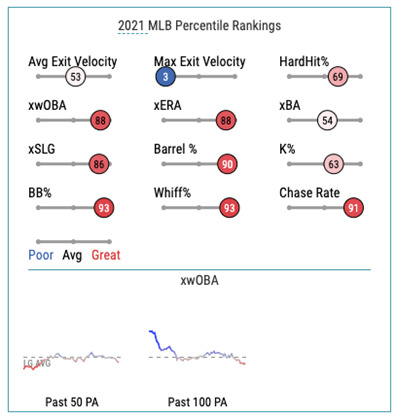
He’s gone to using his change up 81.6% of the time, and that’s a 78 mile per hour pitch with 50.3 inches of drop. That change up has an average exit velocity of 88.5 mph and an average launch angle of 2 degrees, which helps get him his 61.5% ground ball rate. He’s only walking 2.6% of batters and hasn’t allowed a single barrel this season. He’ll mix in an 85mph sinker and a 77mph slider every now and then, but he’s just giving a different look than what anyone else is doing and it’s been successful for him.
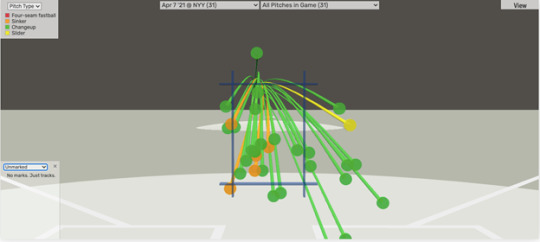
Orioles Lineup
Baltimore hasn’t exactly been laying the lumber this year—they are 29th in OPS+ at 81, t26th in homers with 17, t28th in walks with 48, and have the sixth most strikeouts at 199.

They’ve had some good performers this year, especially Cedric Mullins, but their best hitters this season have been falling off over the past couple weeks.
Worrying for the O’s however is that the prospects that they’ve had called up this year have not been hitting well at all. They have four players on their current team that could be thought of being parts of the next good Orioles team: Ryan Mountcastle, Austin Hays, Anthony Santander, and Ryan McKenna. Of those four, McKenna (the lowest ranked prospect of the group) has the best OPS+ at 59 so far this season. The Orioles do have Adley Rutschman as one of the best prospects in baseball in a couple years to be their everyday catcher, but they don’t really have any top end prospects that should be up this season, and it could be a couple more really rough years in the Charm City.
Yankees Breakdown: Clint Frazier and Brett Gardner
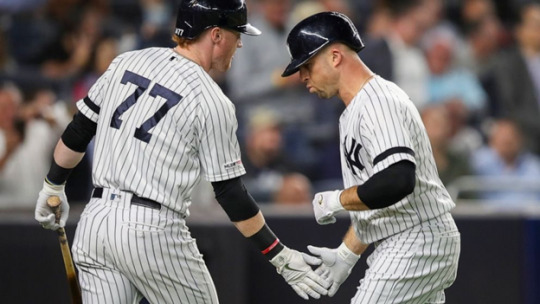
Those are not exactly some good numbers by the potential starting LF for the Yankees. Clint is currently tied for the 9th worst player in fWAR this season at -0.3, and despite being in the 89th percentile in walk rate (16.1%) he’s been pretty bad at about everything else.

Clint has had 28 balls in play this season in 56 PA—those six balls in play are the only ones with at least a .500 xBA. Of his seven hits, three of them are bloop hits, three of them are infield grounders he beat out, and one was a sharp hit double along the line. He’s swinging at 65% of meatballs and at 53.8% of pitches in the zone.
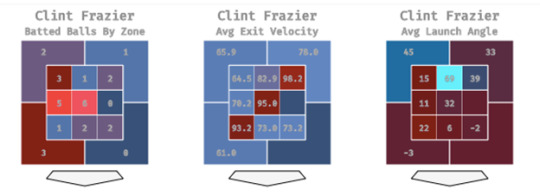
He’s taking too many pitches, and when he does get something to drive he’s either hitting it weakly (77.6mph average exit velocity) or hitting it straight up:

He’s also been awful at fielding with a -3 OAA, catching only 76% of the expected 87% of one to three star catches he should have made. He’s getting -4.6 feet of jump vs the average player, which is far and away the worst of any qualified outfielder (he’s over a foot worse than the second worst outfielder.)
Gardner unfortunately hasn’t done much better- despite the hot start, he has just one hit since April 11th and only two walks. His strikeout rate has continued to increase year over year (up to 25% now) and he’s not doing exactly putting the ball in play a lot either:
Luckily for Gardner’s sake, he’s at least been a good outfielder—0 OAA (which for the Yankees is actually good) and is making 2% more plays than expected. He’s lost some speed, but his reaction time has been really good to keep him as a viable defensive option.
#Yankees#New York Yankees#Orioles#Baltimore Orioles#MLB#Baseball#AL East#Breakdown#Series Preview#Bring Back Gary Thorne
1 note
·
View note
Link
via Politics – FiveThirtyEight
As Democrats press forward with the first phase of their impeachment inquiry, they must try to convince a deeply divided American public that President Trump committed impeachable offenses. And according to our impeachment polling tracker, they might be up against tough odds. Overall support for impeachment has been remarkably steady since October, and Americans’ appetite for impeaching and removing Trump may have even started to plateau.
So we wanted to go one step deeper and understand the state of public opinion beneath those top-line numbers — is there a group of persuadable Americans who are still on the fence about impeachment? And will Americans’ views about what constitutes an impeachable offense shift as Democrats present their case against Trump?
To answer this and more, we’re partnering with Ipsos on a panel survey that will follow the same group of respondents over the next few months, checking in with them at regular intervals to see if their perspective on impeachment has changed. Our first wave of the survey went out last week, as Democrats’ first public hearings unfolded. It revealed that most Americans think Trump has committed an impeachable offense — but Democrats still have some work to do to get the public on board with their case against Trump.
Despite majority support, party splits persist
The initial wave of our survey found that even before articles of impeachment against Trump have been drafted, 56 percent of Americans agree that he has committed an impeachable offense. (We didn’t ask whether respondents believe he should be impeached or removed from office as a result.)
Few Republicans see an impeachable offense
Share of respondents in an Ipsos/FiveThirtyEight poll who said they think Trump has committed an impeachable offense, by party
All 56.2%
–
Democrats 88.7
–
Republicans 18.8
–
From a poll with 2,088 respondents, conducted from Nov. 13 to Nov. 18
Unsurprisingly, though, there’s an enormous gulf between Republicans and Democrats. Democrats are nearly unanimous in their belief that Trump has committed an impeachable offense, whereas 4 out of 5 Republicans believe that he hasn’t.
That doesn’t mean, though, that there isn’t room for public opinion to shift as the hearings move forward. The survey also indicated, crucially, that a significant chunk of Americans are still persuadable when it comes to impeachment. While 42 percent of respondents say they are absolutely certain about their position on impeachment, about a quarter still say they’re either “somewhat” or “not at all certain” about whether Trump committed an impeachable offense.
Within this narrower universe of people who haven’t fully made up their mind, respondents who said they currently don’t believe Trump’s behavior is impeachable were especially likely to say they’re not at all certain about their position. It’s important not to read too much into this, since we’re talking about a relatively small slice of the public1 but it suggests that there’s still room for movement among at least some people who aren’t yet on Democrats’ side.
The public remains divided about crucial facts
In building their case against Trump, Democrats are using a set of key questions that are likely to serve as the foundation for articles of impeachment. In broad strokes, they are:
Did Trump ask Ukraine to investigate Joe Biden and his son Hunter?
Did Trump withhold military aid to pressure the Ukrainians into opening an investigation into the Bidens?
Did the Trump administration try to cover up Trump’s actions regarding Ukraine?
According to our poll with Ipsos, a majority of Americans agree that all three of these things happened and that they’re inappropriate behaviors for a president. But there’s less consensus about whether they’re impeachable offenses. Republicans, in particular, seem unconvinced that any of the three prongs in Democrats’ case against Trump are impeachable offenses.
Partisans disagree on the facts and what they mean
Share of respondents in a FiveThirtyEight/Ipsos poll who believe Trump took certain actions relating to Ukraine and whether, if they did happen, those actions would be impeachable or inappropriate
Trump asked the government of Ukraine to investigate Joe Biden and his son If it happened, it would be … party believe it happened inappropriate impeachable All 77.3%
–
63.5%
–
44.4%
–
Democrats 91.4
–
89.0
–
71.5
–
Republicans 64.0
–
36.1
–
13.8
–
Trump withheld military aid from Ukraine unless it agreed to investigate the Bidens If it happened, it would be … party believe it happened inappropriate impeachable All 56.4%
–
79.6%
–
57.9%
–
Democrats 84.1
–
93.0
–
85.3
–
Republicans 25.8
–
67.1
–
27.4
–
Trump and his administration attempted to cover up his actions regarding Ukraine If it happened, it would be … party believe it happened inappropriate impeachable All 59.4%
–
86.9%
–
58.0%
–
Democrats 88.5
–
94.7
–
84.3
–
Republicans 26.7
–
81.0
–
28.8
–
From a poll with 2,088 respondents, conducted from Nov. 13 to Nov. 18
But the differences in these responses suggests that while the public mostly views Trump’s conduct as serious, it might still be difficult for Democrats to build a broad public consensus around their articles of impeachment. As the table above shows, respondents were more likely to agree that Trump asked Ukraine to investigate the Bidens than to believe that Trump held up security aid over the investigations, or tried to cover up his actions. That makes sense — the White House’s own summary of Trump’s July call with Ukrainian President Volodymyr Zelensky seems to confirm as much. But while most thought all three of those actions would be inappropriate, a bare majority (51 percent) said that Trump asking Ukraine’s government to investigate the Bidens would not be an impeachable offense.
This pattern is especially noticeable among Republicans. They agree, for the most part, that Trump did ask Ukraine to investigate the Bidens. But they mostly don’t think it’s inappropriate or impeachable for Trump to have done so. And while majorities of Republicans think that it would be inappropriate for Trump to have withheld military aid over the investigations or tried to hide information from Congress, they are much less convinced that either of those things actually happened.
But people with doubts aren’t following closely
This could change as the televised hearings wrap up, but right now, the proceedings are getting a lot of attention. Over half (57 percent) of Americans in our survey said they’re following the impeachment proceedings somewhat or very closely, with Democrats a bit more likely to say they’re following closely.
The problem for Democrats is that the people who haven’t fully made up their minds about impeachment — regardless of their political orientation — don’t seem to be very engaged with the process. Only about 34 percent of respondents who aren’t as certain about their stance on impeachment are following the process somewhat or very closely, compared to 66 percent of respondents who are more certain. So while there are people out there who could still be convinced by the Democrats’ case against Trump, they’re also less likely to be paying attention.
Methodology: All the data presented here come from polling done by Ipsos for FiveThirtyEight, using Ipsos’s KnowledgePanel, a probability-based online panel that is recruited to be representative of the U.S. population. For this study, the same group of respondents is contacted for an interview six times — roughly every two weeks for three months — to track whether and how their answers changed; this is the initial wave of this panel survey, conducted from Nov. 13 to Nov. 18 among a general population sample of adults with an oversample of independents, garnering 2,088 respondents. The study weighting included an adjustment for party identification so that results reflect the general population of U.S. adults. The poll has a margin of error of +/- 2.4 percentage points.
2 notes
·
View notes
Text
Analysing VN fans on Steam

To what extent do JVN and EVN fans on Steam overlap? How many VNs do they buy? Who spends more? Which fandom is more elitist? As an update to my last analysis post on VN sales on Steam, I trawled 100k Steam profiles to find out. Here are my results~
Data collection and definitions
Using the Steam API, I checked over a million steam profiles and collected public game lists on just under 100k users. I then used Steam's "Visual Novel" tag to identify which of those games were VNs. As Steam tends to be more lax on its definition of what a VN is, I cross-referenced this with VNDB.org and only included those games that had a VNDB entry. VNs were then split into three categories:
JVNs: non-free VNs created by a Japanese company.
EVNs: non-free VNs created by a primarily English speaking developer.
Free VNs: free VNs created by either a Japanese or English developer. Unlike the non-free categories, users are only counted as "owning" a free VN if they have logged some time playing it.
Those of you who follow my twitter may notice a few of these graphs are different to what I teased earlier. When investigating the overlap between VNs, I consistently found one group of VNs that were an outlier in terms of their fanbase overlap with other VNs, their userbase size, and their average price. It was always the Chinese and Russian VNs. So in the interests of better analysing the English language VN fandom, I restricted the dataset to only those VNs developed originally in English or Japanese.
Results
Let’s start simple and just see how widespread we VN fans are on Steam:

While VNs remain a niche, they seem to be widespread enough among the Steam userbase that most users should at least be familiar with what they are. EVNs are penetrating Steam better than JVNs, perhaps due to bundles and lower prices. But they’ve also been on Steam longer than JVNs, with Analogue: A Hate Story being released back in 2012. Overall, 37.9% of Steam users either own or have played a VN of some kind. But owning one VN doesn’t necessarily make you a fan, so let’s see how many VNs these users own.

The dramatic drop for free VNs show how dependent it is on a few VNs that reach more mainstream attention. 26.5% of free VN users have only played Doki Doki Literature Club for example, and only 53.2% of free VN players have ever bought a VN. This suggests that free VNs might not be an effective strategy for promoting a later commercial release as so few of these users buy VNs.
EVNs drop at a faster rate than JVNs, showing that EVNs’ wider userbase doesn’t necessarily mean they have more users who would identify as VN fans as they tend to only own a couple of VNs. However once we get past the casual crowd, we see EVN owners seem to be more prolific purchasers than JVN owners. EVN owners purchase more VNs on average (5+ EVN owners own 23.7 EVNs on average, whereas 5+ JVN owners own 17.1 JVNs each). This may be because there are 66% more commercial EVNs on Steam than commercial JVNs so there’s more to buy, and they cost far less (the average EVN is £7.31 vs £14.00 for JVNs). So let’s try comparing the average spent on VNs next.

These prices assume users paid full price so are overestimating the total spent, but the relative value between JVNs and EVNs should be fairly accurate.
Here we can see the influence of those higher JVN prices. While EVN fans may buy more, they spend less. On average, EVN owners spend £60.87 while JVN owners spend £81.12. The richest 10% of spenders have a disproportionate influence on the industry, accounting for 60% of all EVN revenue and 53% of JVN revenue. This is broadly in line with the Steam average, where the top 10% of spenders account for 61% of all revenue. So far we’ve been treating JVN owners and EVN owners as distinct entities, as if they were two warring tribes. But are they actually the same users? Let’s investigate the overlap~

Given that 86% of free VNs currently on Steam are by English developers, I expected the free VN fanbase to overlap more with EVNs, but it’s actually JVN owners who play free VNs more frequently, as 62.1% of JVN owners play free VNs but only 52.9% of EVN owners do too. Perhaps it’s because there are more EVN owners who are only lightly into VNs so are less aware of other free VN releases.
Equally surprising is how many JVN owners also own EVNs: 75.2%. Despite the reputation of JVNs being the elitist community, it’s EVNs owners who are less likely to try JVNs where only 52.4% of them own a JVN. "But what about bundles” I hear the comment sections cry. Perhaps some EVN/JVN owners just picked up one in a bundle and aren’t really fans of them? OK, let’s retry this overlap with only those users who have at least 5 EVNs/JVNs/Free VNs in their library.

The biggest drop in size is the free VN category, who lose 88.5% of their users. Meanwhile, the overlap between EVN and JVN fans has only grown tighter; with 60.1% of those who own 5+ EVNs also owning at least 5 JVNs. So it doesn’t seem like bundles explain the strong overlap between JVN and EVN fans, but let’s try another test. If someone picked up a VN through a bundle that they aren’t interested in, they probably wouldn’t play it. So let’s try only counting VNs that have been played:

There’s been a slight drop in how many JVN players also play EVNs, at 67.6%, but it’s still a significant overlap. So while bundles likely do inflate EVN numbers slightly, there’s no denying how linked the fandoms are. Overall, 59.3% of owned JVNs were played, while 56.2% of EVNs were. The lower EVN percentage is perhaps due to user’s owning more EVNs on average. Although both played stats were higher than the Steam average, where only 49.2% of owned games have any recorded playtime.
So what explains the lingering lower JVN ownership among EVN fans? Are EVNs perhaps catering to a wider audience? One thing the EVN scene is known for it its profusion of otomes (VNs with a female protagonist pursuing male love interests), so let’s compare their overlap.

Rather than being more insular, otome fans are even more willing to try VNs developed in another language, with 81.2% of EVN otome owners also owning a JVN, and 90.3% of JVN otome owners also owning EVNs. However the overlap between otomes fandoms is smaller than EVNs/JVNs overall (68.6% of JVN otome owners also own EVN otomes, and 37.9% of EVN otomes owners own a JVN otome). Something that especially stands out is just how many otome fans there are in the VN market. 33.1% of EVN owners and 42.1% of JVN owners own an otome. They make up a significant part of the fandom, but many online VN community hubs either ignore or are outright hostile to them.
So it otome’s don’t explain the EVN/JVN gap, what does? To further investigate we’re going to need to delve into individual VN statistics and look through a lot of lists, so I’ll keep that for my next post in a week or two.
Potential issues
We’ve been basing these statistics on public user profiles, however only 7.4% of Steam users have their game list public. So it’s possible we’re undercounting the more casual userbase who are less likely to have configured their profile to be public.
This has been an analysis of only Steam users, and while Steam is a major part of the game industry, it’s not the only source of VNs. JVN fans may prefer to stick with Mangagamer/Denpasoft etc, while EVN fans may prefer itch.io. So it’s possible the JVN/EVN fandom splits more than these figures would imply.
Conclusion
In my experience, the popular image of the VN fandom is of a male JVN elitist who hates EVNs and would never read an otome, but that really isn’t representative of the customer base. The majority of JVN fans also enjoy EVNs, the average JVN owner owns more EVNs (10.9) than JVNs (7.6). The same is true of EVN fans, who while preferring EVNS (8.5 owned on average) still frequently own JVNs (5.0 owned on average). So the canny VN developer would do well to advertise in both EVN and JVN fandom communities.
I hope you enjoyed the analysis. Please let me know what you think and share any alternative theories you have on these stats. If you’re interested in more, check out my other posts here on tumblr, watch for updates on my twitter, or give me a yell on Discord (Sunleaf_Willow /(^ n ^=)\#1616). Special thanks to /u/8cccc9, Part-time Storier, and Lunaterra for help with the analysis. I just do these analyses for fun, but if you want to support my work with a tip, I accept small donations at ko-fi.
34 notes
·
View notes
Text

Hot Hands
Ladies and gentlemen, your Calgary Flames are officially the hottest team in the NHL. Not only that they are undoubtedly a serious Stanley Cup contender. That’s no small statement either especially considering the massive disappointment they have been the past couple seasons either. That seems far in the rear-view mirror at this point though. At 66 pts in 49 games and a .673 winning percentage, they stand 8th in NHL, 2nd in the Western Conference, and 1st in the Pacific Division. This is thanks in large part to an amazing 10-0-0 record over their past 10 games which includes going a perfect 7-0-0 during their most recent homestand. The home fires have certainly been burning for this crew as they are 14-4-4 at the Dome. The fans in Calgary have been treated to an exciting brand of two-way hockey not seen since the days of Iggy and Kipper.
Preventing goals and being hard to play against was expected when Darryl took over halfway through last season, but the offensive prowess that the Flames have put forth has been a wonderful surprise. They’ve given up a league low 114 goals and 2.33 goals/game with the 4th best PK% at 88.5. This is aided by stingy defence that is giving up the 3rd least shots/game at 28.9/game. As well, Jacob Markstrom is turning in Vezina calibre season so far. He has by far the most shutouts at 8 with the next closest goalies coming in at 4 (Fleury, Campbell, and Sorokin). Of goalies with a minimum 10 games played he is 3rd in save % and GAA at .928 and 2.06 respectively. Jacob trails only Igor Shesterkin (NYR) and Ville Husso (STL) in both those categories. Marky is having his best season of his career so far. His best S% is .918 in 2019-2020 and his best GAA is 2.63 in 2016-2017 (min. 10 games played). He is poised to blow those numbers out of the water with a chance to beat Kiprusoff’s team record 10 shutouts in a season. Perhaps there will be a Vezina trophy at the end of all that, but we know that Markstrom and the Flames only care about one piece of hardware.
The offensive numbers Calgary is putting up have been unexpected to say the least. After all, they didn’t exactly add any big time scoring in the off season with all due respect to Blake Coleman who is much more renowned for his hard 2-way game. The season numbers aren’t mind blowing as they’re 11th in the league in goals for at 167 and 8th in goals/game at 3.41, but the past 15 games are a different story. During that span they have put up 62 goals which works out to 4.13/game! That would place them number 1 overall if sustained over the season to date. Though that is not expected to happen, but a big drop off isn’t either as they should remain top 10 scoring team on the backs of big offensive seasons from key players. Johnny Gaudreau is having a massive bounce back season having already eclipsed his totals from the past 2 disappointing ones. He is 5th in NHL scoring with 64 pts, 3rd in assists with 44, 1st in even strength points with 53, and a league best +/- of +41. With a little more power play production, a top 3 finish overall isn’t out of the question. This has all come about with being teamed up with Elias Lindholm and Matthew Tkachuk on one of the most productive lines. At a point per game (49 pts in 49 games) Lindholm is handling 1st line center duties with aplomb. He has already scored his 3rd most goals in a season at 23 (previous highs of 27 and 29 in 18/19 and 19/20) while providing his usual responsible 2-way play. Combine Johnny and Elias with Tkachuk’s breakout campaign of 56 pts in 49 games and you got a formidable trio. Matthew has made a seamless transition to a full-time right winger and 1st liner. All 3 are likely to have career years if health permits.
Hopefully that all bodes well for the rest of season and into what is hopefully a deep playoff run. Sure, lots of things still need to break right, but the table has been set. They just have to stay within the systems provided by Sutter, keep working hard in all 3 zones, and keep the hot hands firing.
*stats provided by NHL.com and Hockey DB.
By: Jaymee Kitchenham
1 note
·
View note
Text
Failure to teach net-zero architecture skills "is negligent and verges on denialism" says Anthropocene Architecture School founder
Architecture schools must prioritise teaching students net-zero design skills to effectively prepare them for future work, says Anthropocene Architecture School founder Scott McAulay.
Speaking to Dezeen, McAulay said that if the industry is to help alleviate climate change, emerging architects must be taught how to eliminate carbon emissions from the built environment, which is responsible for around 40 per cent of all greenhouse gas emissions.
A failure to do this so far has left a "massive knowledge gap in the industry" in which many architects practice sustainability as a method of damage control, he explained.
Scott McAulay (above) believes architecture students must learn net-zero design skills. He is founder of Anthropocene Architecture School (top) where he teaches climate literacy to architects
"We need to have a really frank conversation about the way we've been practising sustainability as a whole, it has become a buzzword and it is effectively just damage control," McAulay told Dezeen.
"At this point, it needs to be entirely normal to start an architecture degree and to be taught in a context of a climate emergency where we have been told that we should be net-zero and curbing carbon emissions as fast as possible," he continued.
"If [the design of a building] is not basically near net-zero, it's already outdated, it's already archaic," he explained. "It's not performing as we know it needs to, so that has to be the established standard."
"Everything has to change"
Net-zero carbon buildings are designed to eliminate all possible emissions in both embodied carbon, which are emissions caused by the construction supply chain, and operational carbon, which are emissions caused by the building's use. Any remaining emissions must be offset using schemes that remove carbon from the atmosphere.
In 2019, the Royal Institute of British Architects launched a voluntary challenge to help architects design net-zero carbon buildings but less than six per cent of UK studios have signed up.
According to UN champion Nigel Topping, architects are also "one of the least well-represented businesses" in the UN initiative to get companies to commit to net-zero emissions by 2050.
However, the latest IPCC report said that "immediate, rapid and large-scale" cuts to greenhouse gas emissions such as carbon dioxide are what is required to tackle human-induced climate change and help to stabilise global temperatures.
"If you understand the gravity of that report, and you understand what it says about buildings, then you know everything has to change," McAulay reflected.
Climate literacy "has to be rooted"
In addition to teaching zero-carbon design skills, McAulay explained that a wider overhaul of architectural curricula is required to make emerging architects "climate literate".
"Climate literacy means understanding that buildings have a significant impact upon climate change," he explained. "That has to be rooted."
Read:
"Architects need substantive knowledge and skills to address climate change"
This should start with teaching architecture students that "when you work with any building, or you design any building, it goes into an existing ecosystem".
But skills such as landscaping and retrofitting must also be learned, he said, alongside gaining hands-on building experience with sustainable materials such as hempcrete.
He said an example of this is at the Weitzman School of Design's McHarg Centre, where courses are built on the guidelines of the Green New Deal – a proposal for a government-led remodel of the US economy to address climate change by Alexandria Ocasio-Cortez and Edward Markey.
Anthropocene Architecture School provides support
While individual institutions beginning to teach climate literacy is a positive step, McAulay said that legislation and collaboration between different schools are needed for it to be truly effective.
"To not educate students about climate change and sustainability is negligent and verges on denialism," he explained.
"We definitely need [the teaching of climate literacy] to be in legislation, it can't just be left to each individual institution that feels like it," McAulay continued.
"We are yet to see a united collaborative effort, freely sharing learnings and resources, between as many institutions as we need to build the critical mass to catalyse the necessary, transformative change."
Read:
Students "let down by their architectural education" says climate action group
However, recognising that changes in legislation may not happen at the required speed, McAulay is now taking educating emerging architects into his own hands as part of the Anthropocene Architecture School (AAS) – a decentralised architecture organisation that he founded in 2019.
The AAS offers a mix of online resources and workshops that shed light on the changes needed in the industry and the existing resources available to do so. They are available to schools of architecture and their students, as well as tutors, practitioners and the public.
So far this has seen him conduct lectures for staff and students at 15 universities in the UK, the Netherlands and Canada. More recently, he collaborated with students from Manchester School of Architecture as part of its annual programme of student-led live projects, during which they developed replicable Climate Literacy toolkits.
Architecture students feel let down by education
McAulay is far from alone in his concerns about the lack of climate literacy in education. A recent survey conducted by the Architects Climate Action Network (ACAN) revealed that 76.9 per cent of students do not feel their course is properly preparing them for future work.
It also found that 88.5 per cent of students wanted to be tested on their ability to design net-zero buildings, but that "aesthetics are valued more than sustainable design" at their institution.
ACAN's education coordinator Megan Coe told Dezeen that "students feel they are currently being let down by their architectural education".
Achieving net-zero carbon architecture and is one of the topics that Dezeen has explored in its recent editorial series called Carbon revolution. The series also explored ways of removing carbon from the atmosphere through direct air capture and natural processes such as mineral carbonation.
The post Failure to teach net-zero architecture skills "is negligent and verges on denialism" says Anthropocene Architecture School founder appeared first on Dezeen.
0 notes
Text
The Sea And Cake
The Sea And Cake have been making elegant, assured, and singularly unique music for over two decades. The band is made up of a who’s who of Chicago experimental/indie/jazz/post-everything musicians that include Sam Prekop, Archer Prewitt, and John Mcentire.
Their latest album on Thrill Jockey Records is Any Day. Sam Prekop (singer, guitarist) sat down to talk with Pedal Fuzz about writing and recording the record, just after a soundcheck in Durham, NC, ahead of their performance at The Pinhook.
Pedal Fuzz: Your Last album Runner came out in 2012. When did you start working on the songs that would make up Any Day?
Sam Prekop: So it was probably February 2017. Got a bit of a slow start I guess. I started actively playing guitar for that mainly on my acoustic, roaming around my house cooking dinner for the kids. Strumming the guitar, getting it together kind of. And then Archer Prewitt (guitar) and I spent a fair amount of time together before John McEntire (drums) showed up. And then the three of us rehearsed at the practice space for probably about a week with the new material. And then we went into the studio to record the basic tracks.
PF: Is that generally how it's worked in the past, you starting just with the guitar then bringing everyone else in?
SP: So Archer and I spend a lot of time without drums to work out the intricacies of the arrangements. Of course John contributes as well, but to get the ball rolling usually I start, get the basic gist of it, and then I have Archer come in. There's a few songs on the new record that Archer and I came up with just sort of messing around improvising and stuff. So it happens that way as well. "Any Day," the title track comes out of that, and also the last song "These Falling Arms."
PF: Did you record in John’s studio, Soma Studios?
SP: His studio in flux now because he moved to California. So it was different in that regard, so we used a different studio in Chicago. He had already moved right around the time I started working on the guitar stuff.
PF: So did you track in two locations, or just go out there to L.A. and track?
SP: We never made it to L.A. actually. The original plan was to go and mix it and finish it in L.A. And John moved to L.A. but then he bought a house more northern, east of San Francisco. So that kind of threw our plans for a loop a little bit. So John would mix, and then he would send us the files and we would give input on it.
PF: As far as the songwriting. how collaborative does it get once everybody else joins in? By that point do you already have the structure set, or is there room for change?
SP: So when we have the basic tracks, it can still change because I haven't done any singing yet. So I get the basic tracks into my home studio - and I have been doing it this way for a while where I record the vocals at home and mix them later with John. So I spent quite a bit of time writing and singing and recording the vocals on my own basically. I spent more time doing that this time around than other records I would say. I'm not sure why, I think I just found myself with more time.
There were a few setbacks. One was how we thought the studio would be ready in time, so we were kind of waiting for it. Things were hinging on different factors as we were working, so I wound up like, “OK, I have another month to do other stuff,” and so I ended up redoing a lot of things this time around which was good. I think because I got a little bit of time away from what I had done, I got a slight amount of perspective. I could discover that it could be better if I tried to rewrite certain lines or words.
PF: Was it mostly lyrics and vocals you were changing, or other elements?
SP: Sometimes it was just the delivery of it, like I can sort of get more out of the performance. Other times it might be some slight adjustments to the words, or rhythm things, but usually it was that I felt like I could inhabit these vocals more...not intense exactly, but just be more familiar with them. Just to be able to really perform the song.
PF: That's something striking about the record too, it kicks right off with the vocals.
SP: I know - this is the most vocal-centric record of all, and when rehearsing for this tour and playing some older stuff I'm like, "Oh my god I hardly sing at all in long spots." And I have to say the shows have been quite the vocal workout. It's an hour and a half show and I'm singing the whole time. I'm quite burnt by the end.
PF: Are you having to come up with like a honey/lemon regimen?
SP: I should maybe! It's getting better, you know. So this will be maybe our seventh show tonight, and each night it's getting a little easier. It depends on if the monitoring is good and if the sound is good on stage. If I have to over-sing, that's a problem, and sometimes that's the case if I don't hear it properly.
PF: It seems that on this album, compared to some older songs like "The Argument" or even "Harps" from the last record, there's less electronic elements. It has much more of a band feel. How did you decide that was going to be the vibe this time?
SP: Well, usually with these things the project tells you what it wants as you're working on it. I feel like my job is to pay attention as much as possible to what the material is leading you towards. So I didn't start out like, "Oh this should be a super vocal-heavy record and it should be all about that." So as it was leaning in that direction, it seemed like there was just less room for electronic stuff. And I think I think there would have been more of that if we had been in the studio together during the overdub process - which we had planned, but didn't quite happen because of logistics. So that's also part of the reason I think.
PF: Let's talk about gear a little bit. What guitar and amp are you using on the record?
SP: So I started writing on my acoustic. It's a pretty old beat up Martin 000-17. It's a Mahogany, small body kind of deal. And so I write a lot on that. I've never played it live and I don't plan on it - too many problems involved with drums and stuff.
And my main guitar is not actually a Fender Telecaster, though it looks like one. I got it maybe 15 years ago. It was built by Greenwich Village Custom Guitars (GVCG). It's sort of a legendary builder (Jonathan Wilson) which I didn't know at the time. But as soon as I tried it I'm like, "This is my guitar." So that's been my main guitar for a while.
And I use a Fender Bassman amp - but it's not actually a Fender. It's made by Victoria Amp Company out of Chicago (Victoria 45410 Tweed, modeled after a 1959 Bassman). And I've been using that for a long time as well, at least 10 or so years.
PF: What do you like about the Victoria?
SP: It sounds very acoustic. Not like an acoustic guitar, but the sound of the wooden box is very forward in a way. It feels very lively and unveiled in a way that feels very direct. It's very responsive to the way you play, very quick and responsive. There's no reverb or anything, it's a very direct, classic amp design. I imagine it's probably pretty simple. It's designed originally for bass players but it works really well as a guitar amp.
PF: And are you putting anything between the guitar and the amp?
SP: Yeah, I have a few BJFEE pedals, from Norway. Björn Juhl made them, he went on to design Mad Professor pedals. I have one that’s a very subtle overdrive I use all the time called the Honey Bee. And a BJFE EQ pedal (Sea Blue EQ) that’s amazing. I also have a Mad Professor Deep Blue delay pedal I use for a little color – I’m not big on changing my sound per song very much.
PF: You have a very crisp, but full, clean sound.
SP: On the song “Color The Mountain,” I play some pretty distorted guitar. On that I use this Swedish Himmelstrutz Fetto Nord 70 distortion pedal I’ve had a long time. But I don’t use it much.
PF: You’re in a band with people that are in so many other bands, and so many different collaborations. Does that become difficult for everyone to juggle what they have going on?
SP: There’s no real difficulty. That’s why there’s sometimes longer breaks in-between records. So Tortoise had a record in-between, so that was about two years of the lag time. I also make solo records and usually tour on those. No problems really, it’s just a matter of making the plan and it works out.
EDDIE GARCIA PLAYS GUITAR AND ALL THE PEDALS AS 1970S FILM STOCK. YOU CAN ALSO HEAR HIM REPORTING ON NPR AFFILIATE 88.5 WFDD IN WINSTON-SALEM, NC. IN THE WEE HOURS HE RUNS PEDAL FUZZ, WHICH IS A PROUD RECIPIENT OF A GRANT FROM THE ARTS ENTERPRISE LAB / KENAN INSTITUTE FOR THE ARTS.
#The Sea And cake#Sea And Cake#Tortoise#Sam Prekop#Archer Prewitt#John McEntire#Thrill Jockey#Post rock
3 notes
·
View notes
Text
https://www.thedrive.com/the-war-zone/33802/military-helicopters-descend-on-washington-in-bizarre-very-low-altitude-show-of-force
“Daniella Cheslow, a reporter for WAMU 88.5, American University Radio, in Washington, D.C. posted the video seen below of one UH-72 Lakota "parked" above a group of people on Twitter. Steven Dengler, the co-founder of XE Currency, a FOREX software tools and services company, and a licensed helicopter pilot, chimed in to point out that, at least under Federal Aviation Administration rules, this maneuver was very illegal.
Hello! Helicopter pilot here. This hover was 100% illegal.
cc @FAASafetyBrief @FAANews
§ 91.119 Minimum safe altitudes: General.https://t.co/Ot52zQhtW1 pic.twitter.com/O9VwUKv0kD
— Steven Dengler (@Dracogen) June 2, 2020
It also seems bizarrely dangerous. If something were to have happened to the helicopter, it could have quickly fallen into the crowd, offering them little chance to get out of the way. The risk of rotor wash sending debris flying either into the helicopter or toward people on the ground is another risk from this kind of flight profile, especially in a dense urban environment. There is no surveillance value added by hovering at that low of an altitude, quite the contrary actually.”
0 notes
Text
May 11, 2020
Day 132 of the Cute Campaign: Well, I’m dressed today, but I don’t exactly feel “cute,” you know? My outfit feels kinda frumpy but without the coziness, so it just looks thrown-together, but not in in good punk rock way. Maybe not wearing lipstick has something to do with it too. Also, I think I’m just a wee bit tired.
Day 60 of The Q: Still going strong. I hope everyone’s hanging in there. I would really rather not be doing this in the fall. Like, even if I have to do another semester at home (oh God please no), I hope that the libraries are open so I can go there and meet up with friends a few times a week to do work. I know my photo-friend lives a bit far and probably wouldn’t be able to make it most days, but maybe the rest of us could carpool to his area to spend time with him a few times. That’d be nice. And you know what? I honestly wouldn’t care if I went to the library almost every day by myself to get work done. Studying at home is convenient, but, as I’ve said, there’s so little of a distinctions between my home and school life. My bed is, for example, literally a foot and a half away from the desk where I do all of my work. I’ve thankfully stopped doing work on my bed (I did that all through junior and senior year of high school), but it’s still not great.
Alright, so I’m mainly here because I’ve got a grade update: 99% on my math exam!! The one where I could see myself getting anywhere from an 80% to a 100%! That’s pushed my grade up to a 94.8%, meaning that it’s completely possible to get an A overall in the class (93% and up) as opposed to an A-. I just need a 177/200 (88.5%) at least on the final exam, and I’ll be golden. Luckily, we’ve got 48 hours total to complete the final: Thursday and Friday (into Saturday morning, technically), so it’ll be entirely possible to do well on it as long as I make comprehensive review sheets and have all of my notes ready to go. I also plan to go to the two review sessions (and my attendance will totally not at all have anything to do with the fact that they’re being run by the cute, charismatic TA (not my assigned TA who is the definition of un-charismatic) with whom I fell in love many moons ago on that night of the Exam 1 review) tomorrow and Wednesday which will force me to study and review my notes.
Today I have to finish my 200-point chemistry assignment (I’ve drafted most of it over the past week or two, thank God, but there’s still quite a bit to do prior to the submission deadline of 11:59 pm tonight). It’s an entirely possible task to complete, and while I wish, naturally, that I’d done more prior to today, I’m fairly satisfied with what I’ve completed. I should also complete my Anatomy lab practical tonight. I have until tomorrow at noon to complete it, but I’d rather just get it over and done with as soon as possible so that I may have tomorrow mostly to just go to the required classes (and an hour of my review session) and then to celebrate the end of classes.
Ooooh I can’t wait for classes to be done. I’ve really done well pulling my grades up these past few weeks (in all but my chemistry lab, ugh), mostly due to help from my notes during open-note exams, but I’m still proud that I didn’t completely slack off.
Today I’m thankful for my intuition during that math exam. Bruhhh let me tell you our GroupMe was lighting up with people who were upset over this one question. A lot of them used Green’s Thm when they should have been evaluating the line integral of a vector field. Worst part was that both methods yielded the same answer due to a funky Green’s Theorem clause that we’d never discussed. People emailed asking for a regrade and were immediately told “Nope” so now they’ve lost 10 points for that error (I don’t know where I lost my two points (exam was graded out of 100 but 101 points were possible) yet, and hopefully I find out soon). I’m so glad I went slowly through that exam. I’m so lucky that my intuition helped me out.
Wish me luck for getting this chemistry thing in on time (I really have no choice seeing as it’s worth the same amount as the final exam!)!
0 notes
Text
The North Country Primer #2: Marcus Eads, Elk River, MN
Originally published at North Country Primitive in March 2015
Our second installment of The North Country Primer, where we ask a musician a series of questions ranging from the blindingly obvious to the downright dubious, takes us to Minnesota and to guitarist Marcus Eads. Our thanks to Marcus for indulging us.

Tell us a bit about yourself and the musical journey that took you to a place where you concluded that playing an acoustic guitar on your own was a good idea… I bought my first guitar, a $100 Hohner acoustic, when I was fifteen, using paper route money. I taught myself to play on that guitar and it served me well for ten years. I think I’ve always more-or-less played solo, although back in college my older brother and I would occasionally play live shows together. I have a lot of fun these days playing blues guitar with my father-in-law.In the last year or so, since discovering more of the open tunings - mainly open G minor and variations on open C - the guitar has become exciting for me again – as exciting as it had been at fifteen. I really don’t see any limitations for where acoustic guitar music can go. What has influenced your music and why? I spent the nearly the whole of 2013 listening to nothing but 70s era Steely Dan. I still don’t know which album I like more, Aja or Gaucho. Relevant influences right now would be Chuck Johnson and Glenn Jones. Their styles of playing are just effortless sounding. What have you been up to recently? I’m a soon-to-be dad, which is really exciting. My wife and I are having our first child in May. So, I’ve been slowly working on an album of American Primitive-style lullabies… on an open-tuned ukulele. So far I think it’s turning out pretty good - but it’s been more difficult than I’d anticipated. Most of the music you can hear on my Bandcamp or SoundCloud page are improvisational pieces. I record them, and usually never play them the same way again. But an opportunity has come up recently to play a show with two awesome Minneapolis-based musicians, Christoph Bruhn and Nic Garcia. So now I’m having to re-visit and memorise some of my earlier songs in order to create a set list for the evening. It’s fun, but it’s also really stressful. I’m also playing a solo show at the public library in July. What are you listening to right now, old or new? Any recommendations you’d like to share with us? I’ve been listening to this great compilation that came out recently on Tompkins Square called When I Reach That Heavenly Shore: Unearthly Black Gospel, 1926-1936. I’ve also been listening to Jose Gonzalez’s new album, Vestiges and Claws. Aside from that, I listen to Jazz 88.5 on my way to and from work and of course I’m always scouring the internet for fingerstyle guitar. The guitar nerd bit: what guitars do you play and what do you like about them? Is there anything out there you’re coveting? I have three acoustic guitars. The one I play the most is my steel string Cort Earth 70 NS. I also have a hand-me-down Yamaha steel string that I keep permanently in Open G minor tuning. My latest find has been a classical stringed Yahama that I found at the Salvation Army for $20. I love my guitars, but if the opportunity every came up, I’d love to have a Guild guitar like the one that Daniel Bachman plays. It has such a full sound. Banjos: yes or no? My goal in the next few years is to learn the banjo. I just need to find one first. What are you planning to do next? Well, aside from a banjo album, I’d also like to become more proficient in slide guitar. I’d also like to start playing live more. I’d also like to get my ring finger involved in my fingerpicking. Right now I mainly play with thumb, index and middle. I’ve always got something in the works. I would expect an album at least every few months for the foreseeable future. What should we have asked you and didn’t? I’m a native of Seattle, Washington native, where I lived till I was eighteen, I lived in Portland, Oregon for ten years after that. Now I live in Elk River, Minnesota. A lot of the inspiration for Sherburne County Instrumentals was drawn from visits to the Sherburne National Wildlife Refuge just north of where I now live. It’s 30,000 acres of land where you can walk or run for miles and never see another person. It’s a beautiful area. You can listen to and download Marcus’s music at his Bandcamp page at http://marcus-eads.bandcamp.com
0 notes
Text
10 To Watch : Mayor’s Edition 92319
RICK HORROW’S TOP 10 SPORTS/BIZ/TECH/PHILANTHROPY ISSUES FOR THE WEEK OF SEPTEMBER 23 : MAYOR’S EDITION
with Jacob Aere
Indianapolis is the center of the golf world as the LPGA Indy Women in Tech tournament and educational program unfolds this week. The 2019 IWiT field consists of seven out of the Top 10 LPGA Tour money leaders and 17 Solheim Cup players. There are also numerous activities during IWiT Championship week that focus on women and children in technology: The Indy Women in Tech Summit comprises over 600 tech leaders in the community coming together to discuss diversity and inclusion in the workplace, with a session featuring LPGA Tour Pro Mariah Stackhouse and LPGA Chief Brand and Communications Officer Roberta Bowman. Tournament week will also feature the Eureka! Exchange – a fun and engaging area where kids can interact and have fun with hands on tech activities, curated by industry experts. Finally, Nextech’s Pathways to Tech presented by Saint Joseph’s College of Marian University allows two hundred high school students to learn about the different pathways to tech careers. This is a fun experience at the iconic Indianapolis Motor Speedway pagoda providing an opportunity for the next generation of STEM/Tech leaders to interact with Indy tech companies and professionals.
Online lender Social Finance, known as SoFi, will pay more than $30 million annually for the next 20 years to entitle the new NFL stadium under construction in Los Angeles, making it the largest deal in U.S. naming rights history. According to multiple sources, the partnership eclipses the previous NFL high-water mark of $20 million annually at MetLife Stadium, and Chase’s $30 million annual deal with MSG for extensive promotional rights that stop short of entitlement. It may also eclipse Scotiabank’s $40 million deal to rename Air Canada Centre in Toronto in 2017. SoFi’s CEO is Anthony Noto, the NFL’s former CFO. Along with stadium rights, SoFi becomes a sponsor of both tenants, the Chargers and Rams, and will sponsor the adjacent performance venue. SoFi becomes one of Silicon Valley’s biggest sports spenders; it has spent more than $200 million annually on marketing in recent years. It currently claims 800,000 members, with products including student loans, mortgages, personal loans, and wealth management. The company believes the venue will help it become a household financial brand.
Endeavor IPO is back on, aims to raise about $600 million. After a postponement in early August, entertainment giant Endeavor Group filed revised paperwork with the SEC as they move forward with an IPO. The company plans to offer approximately 19.35 million shares of stock for sale, at an estimated price of $30 to $32 per share. (As usual, the underwriters have an option for additional shares.) The company estimates they will received net proceeds of $547-$632 million after expenses. Public investors will own a piece of a money-losing company that carries $4.57 billion in long-term debt. And it will be firmly controlled by the top two executives (Ari Emanuel and Patrick Whitesell) and the controlling investor, Silver Lake Partners; together they will control about 88.5% of the voting power. Endeavor has expanded far beyond its traditional talent agency roots. In the past few years it has acquired the UFC mixed-martial arts circuit, fashion, and sports management group IMG, the Professional Bull Riders tour and streaming provider NeuLion. The transactions are key reasons why the company reported $4.5 billion in debt as of June 30
Digital media rights will be the key driver for the growth of the sports industry over the next five years, with the fourth edition of PricewaterhouseCoopers (PwC) Sports Survey predicting growth in that sector of up to 9.7%. While the PwC paper is enthusiastic on the unrealized potential of digital, it does cast doubts as to whether sports organizations can benefit from online growth, with concerns that the major technology firms will instead be the ones to reap the benefits as both gatekeepers and producers of content. Also a factor, according to the study, will be “much lower growth rates” seen across traditional media streams, which are estimated to be at no more than 4.1% during the same period. Overall, the PwC paper does paint a positive picture of the overall sports market, predicting the industry to grow at a healthy annual rate of 6.4% over the next three to five years. That is below the 7.4% growth of the past three to five years, however, the study insists growth remains "robust."
The Trump administration has announced a national youth sports strategy that will reach beyond in-school physical education and into community-based programs. It will be funded by a legacy endowment with a goal of raising $100 million to provide grants intended to drive increased participation. Developed by the Department of Health & Human Services and the President’s Council on Sports, Fitness & Nutrition, the strategy largely will mirror a draft report issued in June. That report echoed many of the recommendations of those who previously studied participation declines, including the Aspen Institute’s Project Play. Among the focus areas: Recruiting and training of coaches and volunteers, creation of safe places to play, provision of quality equipment and strategies to increase participation among girls. Among the first to sign on in support of the endowment is NBC Sports Group’s Sports Engine -- a leading software provider for youth sports organizations -- which will offer a Premier League Fan Fest trip and other prizes in a sweepstakes to raise funds for the NEYS. Other founding supporters include the NHL, MiLB, UFC, Monumental Sports & Entertainment, the AAU, the Sports & Fitness Industry Association and Boston Scientific.
Athletes attend Harvard to “Crossover Into Business.” The program, taught by Harvard Business School professor Anita Elberse, is "built to help professional athletes be better prepared for business activities during and after their active sports careers,” per Harvard's course description. Participants will each be matched with a pair of Harvard Business School MBA student mentors who will “develop their business acumen and empower them to make better business decisions.” The program is tailored to fit athletes' schedules and interests all while leveraging the "acclaimed Harvard Business School case method.” Athletes taking part in the latest cycle of Harvard Business School's Crossover Into Business program, according to the Boston Herald, include: figure skater Ashley Wagner; tennis players Caroline Wozniacki, Bethanie Mattek-Sands, and Andrea Petkovic; former NFLer Will Beatty; Knicks forward Reggie Bullock; Magic forward Amile Jefferson; NBA free agent Jose Calderon; and former NBAer David Lee. Last year NBA star Kyrie Irving attended the program, along with former NFL tight end Martellus Bennett; NBA players Paul Millsap, Zaza Pachulia, and Spencer Dinwiddie; and other athletes from the WNBA, MLS, UFC, and the American Ballet Theater.
The San Diego Padres are fine with Petco Park hosting the annual KAABOO festival beginning next September. The team has "taken strides to greatly improve how it protects the ballpark's playing surface," according to the San Diego Union-Tribune. Padres President of Business Operations Erik Greupner said that the team "upgraded the protective flooring it uses during in-season non-baseball events a couple years ago." The ballpark in recent years has hosted several concerts and Comic-Con with "no visible damage to the field.” KAABOO, an "upscale music, comedy, art and culinary festival" set to be held September 18-20, 2020, is heading to Petco "after being held for its first five years at the Del Mar Racetrack and adjacent fairgrounds." There is a multiyear contract to hold the event at the ballpark, and Padres season ticket holders will have "access to a special 'loyalty discount'" for the festival. Greupner said landing KAABOO is a "fulfillment of our promise to the people of San Diego that this publicly funded ballpark will (have) more than just baseball."
Esports will get a 24/7 mobile channel with VENN. According to USA Today, the online channel will debut next year with live studios in New York and Los Angeles and aims to be an online video home for esports and game culture - similar to that of ESPN for sports. The channel will be available as an app on streaming and mobile devices, and will offer channels on current video game and esports destinations such as Twitch and YouTube. VENN also plans to put itself on live streaming services such as Sling, YouTube TV, Hulu, and PlutoTV, as well as Snapchat and TikTok for a fittingly full digital presence. Although some of the content will be behind a paywall for enhanced viewer experiences, the majority of the content will be free to watch. In terms of funding, the network's co-CEOs announced $17 million and some of its investors include Twitch co-founder Kevin Lin, Riot Games co-founder Marc Merrill, Blizzard Entertainment co-founder Mike Morhaime, and Blizzard's former global esports head Amy Morhaime. With esports on the rise across pop culture, it is fitting that they will have a space with the best coverage 24/7 on an online platform.
The Travelers Championship in Connecticut raises $2.1 million for 150 local charities. According to the Hartford Courant, representatives from all of the charities — including the primary beneficiary, The Hole in the Wall Gang Camp — were at TPC River Highlands in Cromwell last Tuesday to receive their respective shares. Since taking over as the title sponsor in 2007, Travelers has generated a charitable haul of nearly $20 million. The Travelers Championship donates 100% of its net proceeds to charity, and this year's effort brings the amount generated by the tournament to nearly $20 million since Travelers became title sponsor in 2007. At least 750 charities have benefited over that time. Next year, the tournament will have a huge international name added to the list in the likes of Reigning PGA Tour Player of the Year Rory McIlroy, which will bring even more charity attention to the event.
Proctor and Gamble brand will buy 9,000 tickets to support equal pay for women. The consumer goods corporation’s Secret deodorant will spend $200,000 to buy 9,000 tickets to National Women’s Soccer League games in September and October as part of the brand’s growing effort to support equal pay and opportunity for women’ soccer players. According to Ad Age, Secret will buy 1,000 tickets at one home game for each of the league’s nine teams, offering seats to women’s organizations, youth sports teams, not-for-profit organizations, and other local partners. The brand will also give away Secret products, T-shirts and spirit towels to the first thousand fans at one game in each city. The effort follows an ad Secret launched in March promoting equal pay for the U.S. Women’s National Soccer Team and a $529,000 donation split across the 23 USWNT players in July after it won the Women’s World Cup. Brands have been backing women’s sports, which have also seen a resurgence of interest in broadcast time thanks to digital platforms.
0 notes
Text
The defining NFL season from an older RB, by decade

Not many running backs stick around well into their 30s. These guys did, however — and they still produced.
In a league where players generally don’t play for long, NFL running back careers are especially short. The average career of an NFL player lasts around 2.66 years, as revealed in a 2016 study by the Wall Street Journal. Running backs typically stick around for two years and five months, second only to wideouts.
With the wear and tear that comes with the position, combined with more teams employing running backs by committee, rushers have become even more expendable in today’s NFL. But in every era, there are always a few running backs who have stood the test of time.
We’ve compiled a list of the best individual season by a running back 33 years and older, sorted by decade. All of these players are either in the Hall of Fame — or will be one day.
1960s: John Henry Johnson
The Pittsburgh Steelers drafted Johnson in 1953, but he didn’t end up playing for them until 1960. Used primarily as a fullback, Johnson rushed for more than 700 yards in four of his six seasons with the Steelers while scoring 32 total touchdowns in his time with the team.
In 1962, he came the first Steelers player to ever rush for over 1,000 yards in a single season when he ran for a career-high 1,141 yards. He then did it again two years later as he continued to rack up yardage for the Steelers, capping it off with a one final outstanding season in 1964.
1964 season, age 34/35 years old:
In his 11th season, Johnson ranked third in the NFL with 1,048 rushing yards and 74.9 yards per game. He also finished tied for second in attempts with 235, and tied for third with seven rushing touchdowns. In 1964, Johnson was the only running back over the age of 30 to land in the top five of those categories.
Johnson’s best individual performance came in 1964, too. In a game against the Cleveland Browns, the Steelers rushed for 354 yards — and Johnson was responsible for 200 of them. He also scored all three of Pittsburgh’s touchdowns against its division rival in what was a career day for the running back.
1970s: Larry Csonka
Known as a steamroller, Csonka was the fullback on the great Miami Dolphins teams and ran for a carer-high 1,117 yards in their 1972 undefeated season. He scored six touchdowns during the 1973 playoffs to help them repeat as champions, winning Super Bowl MVP in the process. He rumbled for over 1,000 yards in three straight seasons from 1971 to 1973, making it the best stretch of his career.
Csonka ended up leaving Miami after 1974 and spent three seasons with the New York Giants. However, he came back for one final go-around with the Dolphins in 1979. That season, Csonka rushed for more yards (837) than he had had in six years.
1979 season, age 32/33 years old:
Csonka finished fourth in the league in touchdowns with 12, a career high. Csonka also was in the top 16 in both both rushing attempts and yards, ranking alongside Washington’s John Riggins as the lone running backs over the age of 30 in 1979 to achieve this feat. With Csonka leading the way, Miami won the AFC East with a 10-6 record and the back was awarded the PFWA’s Comeback Player of the Year Award.
In his final NFL season, Csonka still proved to be a scoring machine. Against both the Bears and the Patriots, he totaled three rushing touchdowns in each contest as Miami won by double digits. Those were the only two times Csonka ran for three touchdowns in a single game.
1980s: John Riggins
Riggins is the most accomplished running back in Washington history. He’s the franchise’s all-time leading rusher in attempts, rushing yards, and touchdowns, and Riggins won Super Bowl 17 MVP honors with a 166-yard performance on 38 rushing attempts.
youtube
In nine years with Washington, Riggins seemed to get better as he got older. After turning 29 in 1978, Riggins rushed for over 1,000 yards in four of his next seven seasons and scored 76 touchdowns on the ground during this stretch. Riggins had a stellar season in 1983, rushing for a career-high 24 touchdowns and earning first-team All-Pro honors and the Bert Bell Player of the Year Award. But he had one more excellent year of production in him.
1984 season, age 35 years old:
At age 35, Riggins ranked in the top six among all rushers in attempts (327), rushing yards (1,239), and yards per game (88.5). He also finished tied with Eric Dickerson with a league-leading 14 touchdowns in that 1984 season.
As was the case during this entire career, Riggins was his team’s go-to option when the stakes were the highest. Heading into a Week 15 matchup, both Washington and Dallas were 9-5. The winner would be in sole possession of first place in the NFC East.
Head coach Joe Gibbs put the ball in his lead back’s hands and Riggins responded with 111 yards, more than both of Dallas’ running backs combined that day. He also scored the game-winning touchdown in the fourth quarter. Washington won, 30-28, and ended up taking the NFC East title.
This was the final season for Riggins as Washington’s top back. He only put up 677 rushing yards in 1985, in what turned out to be the last year of his career.
1990s: Marcus Allen
After 11 years with the Raiders, Marcus Allen needed a change of scenery. He found himself splitting carries in Los Angeles with the likes of Bo Jackson and Eric Dickerson, and he also had a falling-out with owner Al Davis.
In 1993, Allen ended up joining their rivals, the Kansas City Chiefs. It was a move which sparked the dislike between the two franchises even more.
Marcus Allen brought a new dynamic to the #Chiefs vs. #Raiders rivalry. Full Episode: http://t.co/GFuILbt471https://t.co/M5CmFtlEdo
— Kansas City Chiefs (@Chiefs) December 12, 2014
Allen flourished in his new role. He ran for an NFL-high 12 touchdowns that season, helping the Chiefs to an 11-5 record. Allen continued to put up decent numbers for Kansas City, capping off a Hall of Fame career with one more big year in 1996.
1996 season, age 36 years old:
When Allen was 36 years old, it was clear his time as a workhorse was coming to an end. In his final season with at least 200 carries, he ran for a team-high 830 yards and nine touchdowns. Although his rushing yards dropped a bit from the 890 he had the year before, his total yards were the same: 1,100. Allen was more of a threat through the air that season, grabbing 27 passes out of the backfield for 270 yards with a catch rate of 77.1 percent, the second-highest percentage of his career.
Allen was the oldest running back to play that season and the most effective over the age of 30. In fact, he was one of only two running backs older than 33 to play in 1996, along with Baltimore’s Earnest Byner. Allen retired from football the following year.
2000s: Emmitt Smith
The 2004 NFL season was Smith’s final chapter in an illustrious career. The Hall of Fame running back finished his career in the desert with the Arizona Cardinals after 13 seasons with the Dallas Cowboys.
Smith’s first season with his new team didn’t go smoothly, as he only rushed for 256 yards and two touchdowns in 2003. Hampered by a broken shoulder he suffered in Week 5 — against the Cowboys of all teams — Smith missed six games and didn’t run for more than 25 yards in any game after his return. This was the first and only time Smith rushed for fewer than 900 yards in his career.
Smith was more durable in 2004, playing in 15 games, and his production picked up as a result.
2004 season, age 35 years old:
The Cardinals weren’t very good in 2004, finishing 6-10 in Dennis Green’s first year as Arizona head coach. But at 35 years old, Smith ran for a team-high 937 yards and nine touchdowns. His 267 attempts also ranked in the top 15 for all rushers.
The highlight of Smith’s season came in a Week 4 matchup against the New Orleans Saints. He ran for a season-high 127 yards on 21 touches, caught an 18-yard reception, and even threw the first — and only — pass of his career: a 21-yard touchdown to Obafemi Ayanbadejo. Smith’s 29-yard touchdown run in the fourth quarter was the longest run of his season as the Cardinals cruised to their first win of the season.
2010s: Adrian Peterson
Peterson wasn’t expected to be the feature back for Washington heading into the 2018 NFL season. It was supposed to be Derrius Guice, a second-round pick from LSU. However, Guice suffered a torn ACL in the preseason.
With Chris Thompson the only running back left on the roster and with his skillset more suited for the passing game, Washington needed to add someone who could take up the majority of the rushes. So, the team signed the 33-year-old Peterson.
Peterson had a legendary 10-year career with the Minnesota Vikings. He put together one last dominant year in the purple and gold in 2015 at the age of 30, with a league-leading 1,485 rushing yards and 11 touchdowns on the ground.
After he left Minnesota, Peterson split his 2017 season between the New Orleans Saints and Arizona Cardinals. It was a disappointing year for Peterson, who only recorded 529 rushing yards and two touchdowns in an injury-shortened season. He was able to rebound the next year, though.
2018 season, age 33 years old:
In his first season with Washington, Peterson led the team with seven rushing touchdowns. He ran the ball 251 times, fifth-highest in the league and finished eighth with 1,042 rushing yards.
With Thompson missing six games due to injury, Peterson had to assume some of the pass-catching duties as well. He had 20 receptions for 208 yards and caught a touchdown pass in a Week 8 win against the Giants. That game against New York was Peterson’s top performance of the season. In addition to the receiving score, he rushed for a season-high 149 yards on 26 carries. He capped it off with a 64-yard run to the end zone late in the game.
Vintage @adrianpeterson. 64 yards. GONE. : FOX #HTTR pic.twitter.com/rzPvZUYYyN
— NFL (@NFL) October 28, 2018
However, Peterson’s efforts weren’t enough to help Washington overcome its quarterback problems after Alex Smith suffered a broken leg. The team finished third in the NFC East with a 7-9 record.
In 2018, Peterson was the only running back in the NFL over 25 to be in the top 10 in rushing yards. He’s not done yet, either. Peterson showed last season he has no plans of slowing down and then signed a two-year deal with Washington in the offseason.
0 notes
Photo
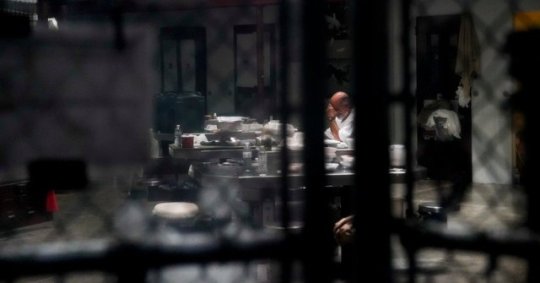
New Post has been published on https://toldnews.com/world/united-states-of-america/guantanamo-bay-as-nursing-home-military-envisions-hospice-care-as-terrorism-suspects-age/
Guantánamo Bay as Nursing Home: Military Envisions Hospice Care as Terrorism Suspects Age
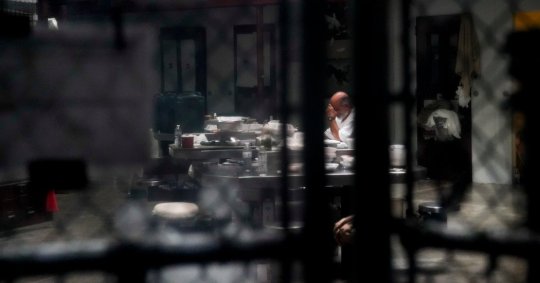
This article was produced in partnership with the Pulitzer Center on Crisis Reporting.
GUANTÁNAMO BAY, Cuba — Nobody has a dementia diagnosis yet, but the first hip and knee replacements are on the horizon. So are wheelchair ramps, sleep apnea breathing masks, grab bars on cell walls and, perhaps, dialysis. Hospice care is on the agenda.
More than 17 years after choosing the American military base in Cuba as “the least worst place” to incarcerate prisoners from the battlefield in Afghanistan, after years of impassioned debates over the rights of the detainees and whether the prison could close, the Pentagon is now planning for terrorism suspects still held in the facility to grow old and die at Guantánamo Bay.
With the Obama administration’s effort to close the prison having been blocked by Congress and the Trump administration committed to keeping it open, and with military trials inching ahead at a glacial pace, commanders were told last year to draw up plans to keep the detention center going for another 25 years, through 2043.
At that point, the oldest prisoner, if he lives that long, would be 96. Another of the 40 people still held here — the Palestinian known as Abu Zubaydah, who was confined to a box the size of a coffin while held at a secret C.I.A. site and waterboarded 83 times to break him — would be 72. Like him, a number of the detainees are already living with what their lawyers say are the physical and psychological aftereffects of torture, making their health especially precarious as they head toward old age.
“Unless America’s policy changes, at some point we’ll be doing some sort of end of life care here,” the commander of the detention center, Rear Adm. John C. Ring, said during a discussion with reporters that highlighted the kinds of questions the prison is asking Pentagon policymakers to decide.
“A lot of my guys are prediabetic,” Admiral Ring said. “Am I going to need dialysis down here? I don’t know. Someone’s got to tell me that. Are we going to do complex cancer care down here? I don’t know. Someone’s got to tell me that.”
The prison is envisioning communal nursing home-style and hospice care confinement of detainees. Already, military commanders say, the detainees now suffer typical middle-age conditions: high blood pressure and cholesterol, joint pain, diabetes and, lately, sleep apnea.
But the military is grappling with an array of questions about how much medical care the prisoners should receive, how it should be delivered and how much Congress will provide to pay for it.
The closest major United States military hospital is in Jacksonville, Fla., 822 miles north. That is where Admiral Ring’s troops go for medical needs that the small base hospital cannot provide, like an M.R.I. But, by law, the military is forbidden to take Guantánamo’s Law of War detainees to the United States.
So most nonroutine medical care has always had to come to the prisoners. Cardiologists have for more than a decade come to consult on some prisoners’ cases. Other specialists have made regular visits to do colonoscopies and examine orthopedic injuries. A prosthetist comes for those with long-healed battlefield amputations.
For now, the military says, no prisoner has cancer and anybody using a wheelchair can get himself in and out of it. But, senior staff members are puzzling through how many cells they will need with grab bars and ramps, and bigger spaces for gurneys, wheelchairs and showers.
“You know, a lot of these folks had hard lives before they came here to Guantánamo Bay,” said the senior medical officer, a Navy commander whose name cannot be disclosed under the military’s rules for visits by journalists to the prison. “We are starting to see the use of canes and walkers and braces and so forth.”
Admiral Ring said the military had no geriatric or palliative care physicians. So he is sending a team to see how the federal Bureau of Prisons handles sick and dying convicts.
The Guantánamo Bay prison has a revolving medical staff of 140 doctors, nurses, medics and mental health care providers. They care for the detainees but also provide some services to the 1,500 troops assigned to the prison, who can go to the base hospital or to the United States for more complex medical care.
Now, the Pentagon is seeking $88.5 million to build a small prison with communal hospice care capacity for the 15 detainees brought here from C.I.A. black sites — six of whom await death penalty trials as alleged conspirators in the attacks of Sept. 11, 2001, and the American destroyer Cole in which nearly 3,000 people died.
The initial cost estimate for the project in 2013 was $49 million. Last year, Admiral Ring estimated it at $69 million. Congress declined to fund it, citing more urgent Defense Department infrastructure needs.
The former black site prisoners are suspected masterminds, deputies or foot soldiers linked to Al Qaeda, and their defense lawyers and medical experts they consult call them Guantánamo’s sickest. Some of the ailments the military attributes to aging, they say, are actually the aftermath of C.I.A. torture.
One prisoner, known as Hambali, 55, an Indonesian who is being held as a former leader of the Southeast Asian extremist group Jemaah Islamiyah, is due for a knee replacement, said his defense lawyer, Maj. James Valentine of the Marines. Major Valentine said the damage to Mr. Hambali’s knee directly resulted from his first year of C.I.A. captivity, when he was always shackled at the ankles.
Mustafa al-Hawsawi, 50, a Saudi man accused of helping the Sept. 11 hijackers with travel and expenses, has for years suffered such chronic rectal pain from being sodomized in the C.I.A. prisons that he sits gingerly on a pillow in court, returns to his cell to recline at the first opportunity and fasts frequently to try to limit bowel movements, said his capital defense lawyer, Walter Ruiz. He has become dependent on a narcotic painkiller called tramadol to make it through the day, Mr. Ruiz said.
It may strike some people as odd that the military is discussing complicated, expensive medical care for the detainees, especially those the Pentagon prosecutor wants sentenced to death.
“It is paradoxical,” said Dr. Stephen N. Xenakis, a psychiatrist and retired Army brigadier general, who has consulted on Guantánamo cases since 2008. “But we don’t let people just die in this country. It violates all of our ethics, our medical ethics.”
Even before most of the detainees reach old age, the prison has confronted the challenges of providing sophisticated medical care under the constraints imposed on it.
In summer 2017, guards found an accused war criminal, Abd al Hadi al Iraqi, incontinent in his cell. He had complained for years about debilitating back pain from degenerative disc disease. A hurricane was headed to the Caribbean, and the Pentagon rushed a Navy neurosurgical team to the base to do an emergency spine surgery.
Recently released court documents in Mr. Hadi’s case challenge the assertion of commanders who say they provide detainees with excellent health care on par with American service members.
He underwent three spine surgeries in September 2017, the first on his lower back, another on his neck and a third to drain a postoperative hematoma. Then, that October, a senior officer at Guantánamo’s community hospital declared in an email that the patient’s “cervical fusion has failed.”
The officer, whose name was redacted in the court record, offered three possible options: giving Mr. Hadi a neck brace and hoping for the best; bringing in a special screwdriver from a Navy hospital in Portsmouth, Va., to remove hardware inserted in the patient’s neck in an earlier operation, or transporting him to the Portsmouth hospital for complex surgery.
In a rare admission of the limits of medicine at Guantánamo, the naval officer added that “the prospect of attempting” that complicated operation at the base hospital here “scares the hell out of me.”
What happened next is not in the court records. But Col. Amanda Azubuike of the Army, a spokeswoman for the Southern Command, which oversees the prison, said by email that the idea of airlifting the prisoner “was obviously not pursued nor explored further given the legal restrictions.”
Two more operations on Mr. Hadi would follow at Guantánamo.
Court filings show Mr. Hadi has chronic pain and back spasms, for which he is prescribed a variety of painkillers and muscle relaxants. His surgeon has testified that Mr. Hadi may not improve. At a hearing on his case in March, guards brought him to court in a wheelchair; he used a walker to transfer to a cushioned rehabilitation chair. The hearing abruptly recessed when one of his lawyers said Mr. Hadi’s answers were not tracking with questions his legal team was putting to him.
Mr. Hadi, now 58, has a February 2020 trial date. To ensure his attendance, the Pentagon fast-tracked bringing a wheelchair-accessible holding cell to the court compound where legal proceedings take place. It was already on order in anticipation of a population of aging detainees.
It is triple the size of the court’s other five holding cells, large enough to hold a hospital bed and, according to a case prosecutor, will have a video monitor so Mr. Hadi can watch a feed of his trial from the bed. It will also have a phone to let him or a lawyer call the courtroom next door, if he has something to say.
The military has already figured out what to do when a detainee dies because that has happened nine times since 2006.
Muslim employees on base offered the deceased their traditional rites until a Muslim chaplain arrived to take over. The State Department then arranged to repatriate the prisoners’ remains.
For those who cannot be repatriated, there is a chain-linked-fence ringed plot of land marked “Entrance Islamic Cemetery” on an off-limits portion of Guantánamo. The last time a reporter was able to visit it, in 2016, it was empty.
#b b c news us#tesla model 3 us news#usa news government#usa news mueller#usa news wells fargo#usa news zte
0 notes